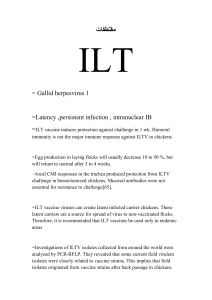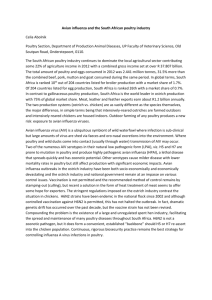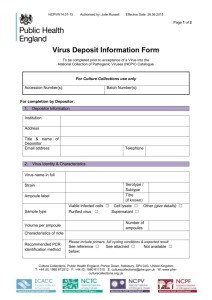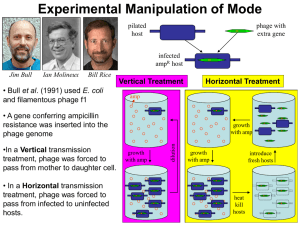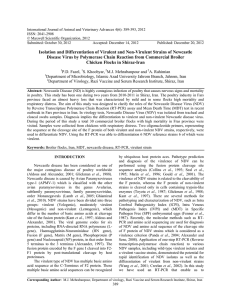Newcastle Disease (Paramyxovirus 1)
advertisement
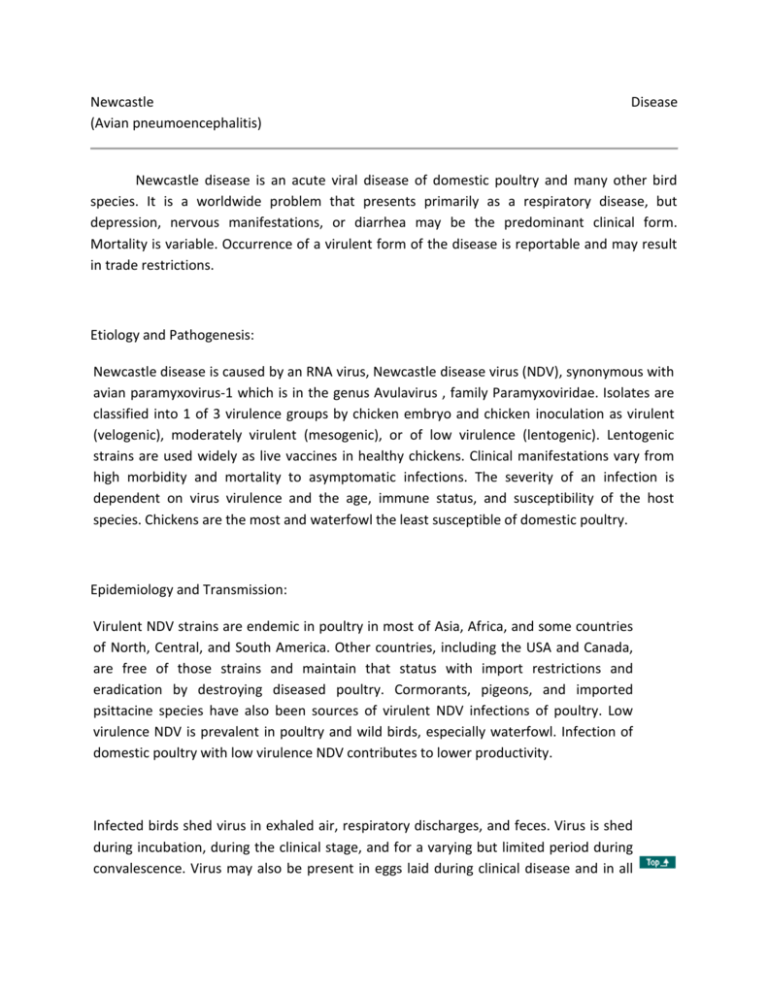
Newcastle (Avian pneumoencephalitis) Disease Newcastle disease is an acute viral disease of domestic poultry and many other bird species. It is a worldwide problem that presents primarily as a respiratory disease, but depression, nervous manifestations, or diarrhea may be the predominant clinical form. Mortality is variable. Occurrence of a virulent form of the disease is reportable and may result in trade restrictions. Etiology and Pathogenesis: Newcastle disease is caused by an RNA virus, Newcastle disease virus (NDV), synonymous with avian paramyxovirus-1 which is in the genus Avulavirus , family Paramyxoviridae. Isolates are classified into 1 of 3 virulence groups by chicken embryo and chicken inoculation as virulent (velogenic), moderately virulent (mesogenic), or of low virulence (lentogenic). Lentogenic strains are used widely as live vaccines in healthy chickens. Clinical manifestations vary from high morbidity and mortality to asymptomatic infections. The severity of an infection is dependent on virus virulence and the age, immune status, and susceptibility of the host species. Chickens are the most and waterfowl the least susceptible of domestic poultry. Epidemiology and Transmission: Virulent NDV strains are endemic in poultry in most of Asia, Africa, and some countries of North, Central, and South America. Other countries, including the USA and Canada, are free of those strains and maintain that status with import restrictions and eradication by destroying diseased poultry. Cormorants, pigeons, and imported psittacine species have also been sources of virulent NDV infections of poultry. Low virulence NDV is prevalent in poultry and wild birds, especially waterfowl. Infection of domestic poultry with low virulence NDV contributes to lower productivity. Infected birds shed virus in exhaled air, respiratory discharges, and feces. Virus is shed during incubation, during the clinical stage, and for a varying but limited period during convalescence. Virus may also be present in eggs laid during clinical disease and in all parts of the carcass during acute virulent infections. Chickens are readily infected by aerosols and by ingesting contaminated water or food. Infected chickens are the primary source of virus, but other domestic and wild birds may be sources of NDV. Transfer of virus, especially in infective feces, by the movement of people and contaminated equipment is the main method of spread between poultry flocks. Clinical Findings: Onset is rapid, and signs appear throughout the flock within 2-12 days (average 5) after aerosol exposure. Spread is slower if the fecal-oral route is the primary means of transmission, particularly for caged birds. Young birds are the most susceptible. Observed signs depend on whether the infecting virus has a predilection for respiratory, digestive, or nervous systems. Respiratory signs of gasping, coughing, sneezing, and rales predominate in low virulence infections. Nervous signs of tremors, paralyzed wings and legs, twisted necks, circling, clonic spasms, and complete paralysis may accompany, but usually follow, the respiratory signs in neurotropic velogenic disease. Nervous signs with diarrhea are typical in pigeons, and nervous signs are frequently seen in cormorants and exotic bird species. Respiratory signs with depression, waterygreenish diarrhea, and swelling of the tissues of the head and neck are typical of the most virulent form of the disease, viscerotropic velogenic Newcastle disease (VVND, also called exotic Newcastle disease), although nervous signs may also be seen. Varying degrees of depression and inappetence are observed. A partial or complete cessation of egg production may occur. Eggs may be abnormal in color, shape, or surface, and have watery albumen. Mortality is variable but can be as high as 100%. Lesions: Remarkable gross lesions are usually observed only with VVND. Petechiae may be seen on the serous membranes; hemorrhages of the proventricular mucosa and intestinal serosa are accompanied by multifocal, necrotic hemorrhagic areas on the mucosal surface of the intestine, especially at lymphoid foci such as cecal tonsils. Splenic necrosis and hemorrhage and edema around the thymus may also be observed. In contrast, the lesions in birds infected with lower virulence NDV strains may be limited to congestion and mucoid exudates seen in the respiratory tract with opacity and thickening of the air sacs. Secondary bacterial infections will increase the severity of the respiratory lesions. Diagnosis: Diagnosis may be confirmed by isolation of a hemagglutinating virus identified by inhibition with Newcastle disease antiserum. A rise in hemagglutination-inhibition antibodies in paired serum samples also confirms the disease. The acute form should be differentiated from highly pathogenic avian influenza (Avian Influenza: Introduction). Virulence of an isolate is established by the rapidity of killing day-old chicks inoculated by the intracerebral route, the intracerebral pathogenicity index, or by the presence of a specified amino acid motif at the cleavage site of the fusion protein (F) precursor (FO). Reference laboratories use monoclonal antibodies to detect antigenic differences and nucleotide sequence analysis to detect genetic differences for comparison of isolates from different outbreaks and to identify the source of those infections. Prevention: Live lentogenic vaccines, chiefly B1 and LaSota strains, are widely used and typically administered to poultry by mass application in drinking water or by spray. Alternatively, individual administration is via the nares or conjunctival sac. Healthy chicks are vaccinated as early as day 1-4 of life. However, delaying vaccination until the second or third week avoids maternal antibody interference with an active immune response. Mycoplasma , some other bacteria, and other viruses affecting the respiratory tract, if present, may act synergistically with some vaccines to aggravate the vaccine reaction after spray administration. Oil-adjuvanted inactivated vaccines are also used following live vaccine in breeders and layers and may be used alone in situations where use of live virus may be contraindicated. In countries where virulent NDV is endemic, a combination of live virus and inactivated vaccine can be used; or alternatively, if permitted by law, a live mesogenic strain vaccine may be used in older birds. The frequency of revaccination to protect chickens throughout life largely depends on the risk of exposure and virulence of the field virus challenge. Zoonotic Risk: Newcastle disease viruses, whether virulent field viruses or live vaccine, can produce a transitory conjunctivitis in humans, but the condition has been limited primarily to laboratory workers and vaccination teams exposed to large quantities of virus. Before poultry vaccination was widely practiced, conjunctivitis from NDV infection occurred in crews eviscerating poultry in processing plants. The disease has not been reported in people who rear poultry or consume poultry products. http://www.merckvetmanual.com/mvm/index.jsp?cfile=htm/bc/203702.htm Newcastle Disease (Paramyxovirus 1) Introduction Paramyxovirus 1 or Newcastle Disease is a highly contagious viral disease affecting poultry of all ages. Affected species include chickens, turkeys, pigeons and ducks. The condition is rarely diagnosed in ducks but is a possible cause of production drops/fertility problems. Other species can be infected including mammals occasionally (e.g. conjunctivitis in man). The virus involved is Paramyxovirus PMV-1, which is of variable pathogenicity. Signs are typically of disease of the nervous, respiratory or reproductive systems. Morbidity is usually high and mortality varies 0-100%. Higher mortality is seen in velogenic disease in unvaccinated stock. Four manifestations have been identified: ND - Velogenic Viscerotropic (VVND) - sometimes called 'asiatic' or exotic. It is highly virulent for chickens, less for turkeys and relatively apathogenic in psittacines. ND - Neurotropic Velogenic - Acute and fatal in chickens of any age causing neurological and some respiratory signs. Intestinal lesions are absent. ND - Mesogenic - Mortality and nervous signs in adult. These viruses have sometimes been used as vaccines in previously immunised birds. ND - Lentogenic - Mild disease, sometimes subclinical. Can affect any age. Strains can be developed as vaccines. Transmission is via aerosols, birds, fomites, visitors and imported psittacines (often asymptomatic). It is not usually vertical (but chicks may become infected in hatcheries from contaminated shells). The virus survives for long periods at ambient temperature, especially in faeces and can persist in houses (in faeces, dust etc). for up to 12 months. However it is quite sensitive to disinfectants, fumigants and sunlight. It is inactivated by temperatures of 56°C for 3 hours or 60°C for 30 min, acid pH, formalin and phenol, and is ether sensitive. Signs Signs are highly variable and will depend on the nature of the infecting virus (see above), the infective dose and the degree of immunity from previous exposure or vaccination. Sudden Death Depression. Inappetance. Coughing. Dyspnoea. Diarrhoea. Nervous signs. Paralysis. Twisted neck. Severe drop in egg production. Moult. Post-mortem lesions Airsacculitis. Tracheitis. Necrotic plaques in proventriculus, intestine, caecal tonsil. Haemorrhage in proventriculus. Intestinal lesions primarily occur in the viscerotropic form. Diagnosis A presumptive diagnosis may be made on signs, post-mortem lesions, rising titre in serology. It is confirmed by isolation in CE, HA+, HI with ND serum or DID (less cross reactions), IFA. Cross-reactions have mainly been with PMV-3. Pathogenicity evaluated by Mean Death Time in embryos, intracerebral or IV pathogenicity in chicks. Samples - tracheal or cloacal. Differentiate from Infectious bronchitis, laryngotracheitis, infectious coryza, avian influenza, EDS-76, haemorrhagic disease, encephalomyelitis, encephalomalacia, intoxications, middle ear infection/skull osteitis, pneumovirus infection. Treatment None, antibiotics to control secondary bacteria. Prevention Quarantine, biosecurity, all-in/all-out production, vaccination. It is common to monitor response to vaccination, especially in breeding birds by the use of routine serological monitoring. HI has been used extensively; Elisa is now also used. These tests do not directly evaluate mucosal immunity, however. Vaccination programmes should use vaccines of high potency, which are adequately stored and take into account the local conditions. A typical programme may involve Hitchner B1 vaccine at day old followed by LaSotatype vaccine at 14 days. The LaSota-type vaccine may even repeated at 35-40 days of age if risk is high. Use of spray application is recommended but it needs to be applied with care to achieve good protection with minimal reaction. Figure 28. Severe haemorrhagic and necrotic lesions in proventriculus and Peyers patches in the intestines of a broiler chicken suffering from one of the severe forms of Newcastle disease (viscerotropic velogenic). Inactivated vaccines have largely replaced the use of live vaccines in lay but they do not prevent local infections. To prevent or reduce vaccinal reactions in young chicks it is important that day old have uniform titres of maternal immunity. Vaccinal reactions may present as conjunctivitis, snicking, and occasionally gasping due to a plug of pus in the lower trachea. In some countries it has been customary to provide antibiotics prophylactically during periods of anticipated vaccinal reaction. Use of Mycoplasma gallisepticum free stock under good management reduces the risk of vaccinal reactions. http://www.thepoultrysite.com/diseaseinfo/111/newcastle-disease-paramyxovirus-1
